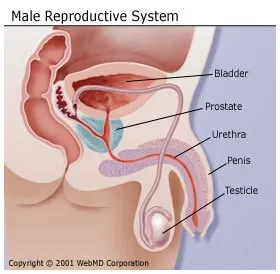The purpose of the organs of the male reproductive system is to perform the following functions:
- To produce, maintain and transport sperm (the male reproductive cells) and protective fluid (semen)
- To discharge sperm within the female reproductive tract during sex
- To produce and secrete male sex hormones responsible for maintaining the male reproductive system

Unlike the female reproductive system, most of the male reproductive system is located outside of the body. These external structures include the penis, scrotum, and testicles.
-
Penis: This is the male organ used in sexual intercourse. It has 3 parts: the root, which attaches to the wall of the abdomen; the body, or shaft; and the glans, which is the cone-shaped part at the end of the penis. The glans, also called the head of the penis, is covered with a loose layer of skin called foreskin. (This skin is sometimes removed in a procedure called circumcision.) The opening of the urethra, the tube that transports semen and urine, is at the tip of the penis. The penis also contains a number of sensitive nerve endings.
The body of the penis is cylindrical in shape and consists of 3 circular shaped chambers. These chambers are made up of special, sponge-like tissue. This tissue contains thousands of large spaces that fill with blood when the man is sexually aroused. As the penis fills with blood, it becomes rigid and erect, which allows for penetration during sexual intercourse. The skin of the penis is loose and elastic to accommodate changes in penis size during an erection.
Semen, which contains sperm (reproductive cells), is expelled (ejaculated) through the end of the penis when the man reaches sexual climax (orgasm). When the penis is erect, the flow of urine is blocked from the urethra, allowing only semen to be ejaculated at orgasm.
-
Scrotum: This is the loose pouch-like sac of skin that hangs behind the penis. It contains the testicles (also called testes), as well as many nerves and blood vessels. The scrotum acts as a "climate control system" for the testes. For normal sperm development, the testes must be at a temperature slightly cooler than body temperature. Special muscles in the wall of the scrotum allow it to contract and relax, moving the testicles closer to the body for warmth or farther away from the body to cool the temperature.
- Testicles (testes): These are oval organs about the size of large olives that lie in the scrotum, secured at either end by a structure called the spermatic cord. Most men have two testes. The testes are responsible for making testosterone, the primary male sex hormone, and for generating sperm. Within the testes are coiled masses of tubes called seminiferous tubules. These tubes are responsible for producing sperm cells.